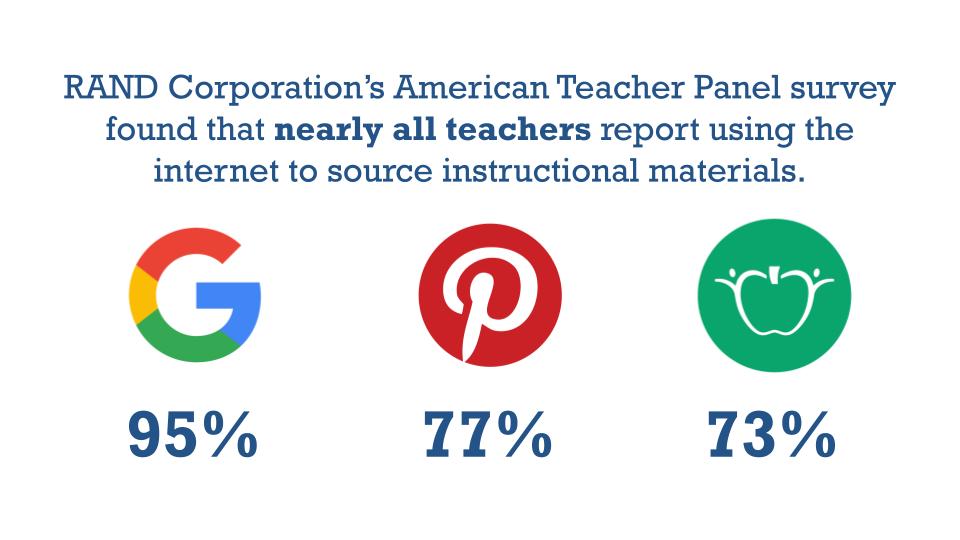Many studies show that the instructional materials a teacher selects are critical if they are to have a direct impact on learning (Jackson and Makarin, 2018). They also show that:
Educators may choose to supplement their established curriculum for a variety of reasons. Research from Polikoff & Silver (2021) shows that adopted curriculum forms a small portion of "enacted curriculum," or what is actually taught to students. Choosing to supplement established curriculum with other resources is usually not a random process. Instead it is influenced by teacher-, school-, and textbook-level characteristics. This suggests that the supplementation process is influenced by structures and policies beyond the individual teacher's control. It is significant thta nearly all teachers source instructional materials online, with 95 percent using Google, 77 percent using Pinterest, and 73 percent using paid sites like Teachers Pay Teachers (Opfer et al., 2016).

Using supplemental materials in the classroom can offer benefits such as enhancing learning, motivating students, and providing support for those who need it. Supplemental resources can allow for exploratory learning and provide opportunities for students to explore topics of interest to them. This increases their motivation in subsequent topics in the subject area. They can also help students who might struggle or need additional support. The resources allow these students to see ideas presented in different ways and give them additional opportunities to succeed.
Supplemental resources allow teachers to use proactive and reactive supports that reduce roadblocks to learning. This makes way for them to practice just-in-time teaching and reteaching. Having aligned and engaging materials also lets teachers plan and implement more innovative, effective teaching strategies than may have been possible before.
Used appropriately, these resources can be a powerful tool in motivating, engaging, and supporting students as they work through course elements. In essence, supplemental materials both enrich the learning environment and cater to the diverse learning needs and interests of students. This offers students a more personalized and engaging learning experience (Shaw, 2020).
The Thomas B. Fordham Institute, in a 2019 study, interviewed teachers about why they turn to online supplemental instructional materials and curriculum. Their responses include:
Chingos, M. M., & Whitehurst, G. J. (2012). Choosing blindly: Instructional materials, teacher effectiveness, and the Common Core. Brookings Institution. https://www.brookings.edu/research/choosing-blindly-instructional-materials-teacher-effectiveness-and-the-common-core/
Jackson, C. K., & Makarin, A. (2018). Can Online Off-the-Shelf Lessons Improve Student Outcomes? Evidence from a Field Experiment. American Economic Journal: Economic Policy, 10(3), 226-254.
Opfer, V. D., Kaufman, J. H., & Thompson, L. E. (2016). Implementation of K–12 State Standards for Mathematics and English Language Arts and Literacy: Findings from the American Teacher Panel. Rand Corporation. https://www.rand.org/pubs/research_reports/RR1529-1.html
Polikoff, M. S., & Silver, D. (2021). Identifying and distinguishing among teachers’ supplementary curriculum use patterns using the lasso. In Frontiers in Education (p. 329). Frontiers.
Polikoff, M.S., & Dean, J. (2019, December). The Supplemental-Curriculum Bazaar: Is What's Online Any Good? Thomas B. Fordham Institute. https://fordhaminstitute.org/national/research/supplemental-curriculum-bazaar
Shaw, Adam. (2020, January 31). Using Supplemental Resources in the Online Classroom. Center for Teaching and Learning | Wiley Education Services. https://ctl.wiley.com/using-supplemental-resources-online-classroom/.
Zubrzycki, J. (2016, August 1). Teachers Seek High-Quality Standards-Aligned Curriculum. Education Week. https://www.edweek.org/ew/articles/2016/08/01/most-teachers-see-the-curriculum-in-their.html
Fetch is avaiable to INFOhio automated schools. If you are an INFOhio school, please log in with your school username/password using the button at the top-left corner of this page.
For more information about Fetch, please visit the Fetch information page or contact INFOhio support at https://support.infohio.org.